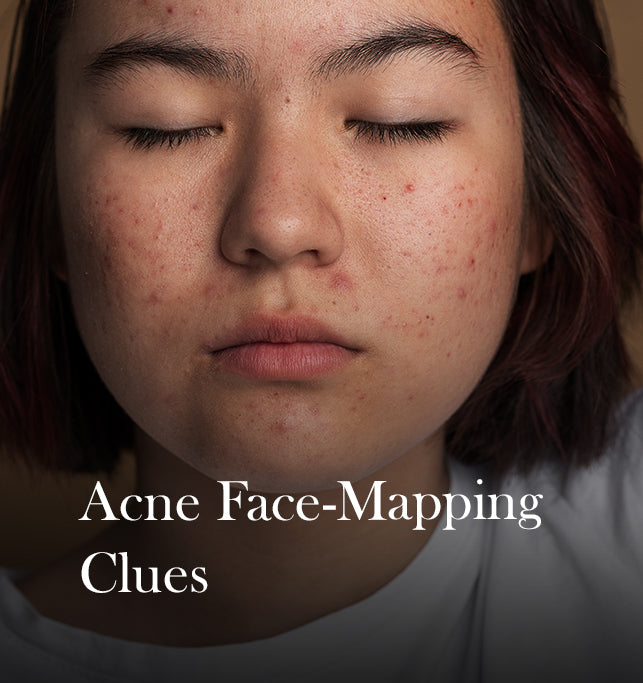Reading the Signs: How to Identify the Causes of Acne Based on Where It Appears on Your Face


Acne is a common skin condition that can occur at any age and can be caused by a variety of factors, including hormonal changes, genetics, and lifestyle factors such as diet and stress. One interesting approach to understanding the causes of acne is by examining where it appears on the face. Here are some common areas of the face where acne can appear and what it may indicate:
Forehead
Acne on the forehead can be exacerbated by a poor diet and food allergies. Keep a food journal to see if there are any trends between your diet and your breakouts. Dairy products, meals with a high glycemic index, and foods high in iodine are all significant dietary causes. Hair products containing oils, silicones, or other heavy components might lead to forehead acne. To test whether it makes a difference, try using lighter, oil-free hair products. Acne on the forehead and other parts of the face can be caused by stress. Incorporate stress-reduction practices into your regular routine, such as meditation, yoga, or deep breathing exercises. Acne on the forehead can be exacerbated by harsh or irritating skincare products. Consider using moderate, non-comedogenic products instead of heavy moisturizers or fragranced products. As previously stated, an imbalance in the gut flora can lead to forehead acne. To enhance gut health, consider including probiotics or fermented foods in your diet.
T-Zone (nose, forehead, and chin)
Acne in the T-zone occurs when the skin's sebaceous glands generate excessive sebum or oil. Because the T-zone has more sebaceous glands than other parts of the face, it is more prone to acne. Excess sebum can block pores and develop comedones, which are non-inflammatory kinds of acne including blackheads and whiteheads when it combines with dead skin cells. Inflammatory acne such as papules, pustules, and cysts can occur when the pores get contaminated with bacteria. Hormonal imbalances, stress, heredity, certain medicines, and lifestyle behaviors such as a diet heavy in sugar or dairy items can all contribute to T-zone acne. While T-zone acne is widespread, it is manageable with good skincare and lifestyle choices. It is critical to be careful with the skin and avoid using harsh products or extensive scrubbing since they can irritate the skin and worsen acne. A dermatologist may be able to give additional treatment choices to help control acne if it is severe or chronic.
Cheeks
Makeup and skincare products can also contribute to cheek acne. Consider switching to non-comedogenic products and avoiding heavy, oil-based, or fragranced products. Your phone may serve as a breeding ground for germs, which can lead to cheek acne. Make it a habit to clean your phone using disinfectant wipes on a regular basis. Touching your face can transmit germs and oil from your hands to your face, contributing to cheek acne. As much as possible, avoid touching your face. As previously said, nutrition can also play a role in acne. Keep a food journal to see if there are any trends between your diet and your breakouts. Stress can also lead to cheek acne. Consider adopting stress-reduction tactics like meditation.
Jawline and chin
Hormone fluctuations, particularly an increase in androgens such as testosterone, can cause the skin's sebaceous glands to generate more oil, resulting in blocked pores and the production of acne. During puberty, menstruation, pregnancy, and menopause, hormonal imbalances can develop. Acne can be exacerbated by not cleaning the face on a regular basis, using harsh or irritating skincare products, or failing to remove makeup before bed.
A high-sugar, dairy-based, and processed-food diet can aggravate acne by raising inflammation in the body. Stress causes the body to create more cortisol, which causes the sebaceous glands to produce more oil, resulting in acne. Acne can be inherited, and some people are predisposed to develop acne around the jawline and chin owing to their genetic composition. If you have acne on your jawline and chin, you must take action to control it. This may involve using a mild cleanser on a regular basis, using non-comedogenic skincare products, avoiding touching the face, eating a nutritious diet, reducing stress, and getting treatment from a dermatologist if acne is severe
Neck and chest
Acne on the neck and chest can develop for the same reasons as acne on the face does. Hormonal imbalances, like acne on the face, can lead to the development of acne on the neck and chest. Androgens, such as testosterone, can increase the skin's sebaceous glands to generate more oil, resulting in blocked pores and acne. Acne can be inherited, and some people may be predisposed to getting acne on the neck and chest as a result of their genetic composition.
Wearing clothing that is too tight or made of synthetic materials can trap perspiration and oil against the skin, resulting in blocked pores and acne. Heat and humidity can cause the skin to generate extra oil, leading to blocked pores and acne. Acne can be exacerbated by not washing the neck and chest on a regular basis or by using harsh or irritating skincare products. If you have acne on your neck and chest, there are things you may do to treat it. Wearing loose clothing made of natural fabrics, washing the afflicted region on a regular basis with a mild cleanser, avoiding harsh or irritating skincare products, and getting treatment from a specialist if acne persists are all examples.
